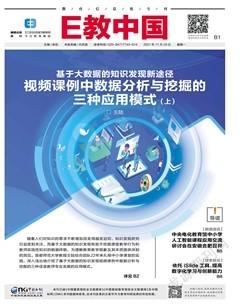Digital Education Outlook 2021(Ⅰ) 译题:2021年数字教育发展观(一)
Product by OECD (Organization for Economic Co-operation and Development) 經济合作与发展组织
该报告向我们介绍了应用于教育领域的前沿技术,包括人工智能、机器人和区块链等,并重点讨论了这些智能技术如何为远程教育带来更丰富的教学模式和更系统的管理方法。
Executive Summary
Digitalisation opens up new possibilities for education. While education has always been rich in data such as grades or administrative information on students’ absenteeism, the use of data to help students learn better and teachers to teach better, and to inform decision-making in educational administrations is recent. Education stakeholders have had a difficult relationship with technology, alternating between strong enthusiasm and scepticism. Might digital technology, and, notably, smart, technologies based on artificial intelligence, learning analytics, robotics, and others, transform education in the same way they are transforming the rest of society? The book focuses on how smart technologies can change education in the classroom and support the management of education organisations and systems.
Smart technologies in the classroom
Adaptive learning technology such as intelligent tutoring systems enable the personalisation of students' learning using similar approaches: they detect the knowledge (or knowledge gaps) of students; they diagnose the next appropriate steps for students’ learning; they act by providing new exercises, new curriculum units, some form of instruction, or just notifying the teacher. This approach is now being expanded beyond mere knowledge acquisition and factoring in behavioural dimensions such as learning self-regulation or style.
As keeping students engaged and motivated is key to learning effectiveness, a new domain of technology development focuses on measuring engagement and interventions to keep students engaged, both in digital and physical learning environments. Measuring engagement is difficult but a host of new automated approaches have been developed, from eye trackers to the monitoring and analysis of other facial features. Improving engagement typically takes two routes: proactive approaches try to stimulate engagement with incentives, gamification, etc.; reactive approaches do it in a more sophisticated way by continually monitoring engagement, detecting when engagement is waning, and adapting instruction to address periods of disengagement.
While smart technologies focusing on personalising learning for individuals are probably the most pervasive, another approach is to consider the classroom or rather what happens in the classroom as the subject of the learning analytics. The objective is to support teachers in orchestrating the learning in their classroom and to propose rich and effective learning scenarios to their students. Some classroom analytics techniques provide teachers with real-time feedback to help manage transitions from one task to the next as their students work individually, in small groups or collectively, for example. They also give feedback to teachers on their classroom behaviour so they can reflect on and learn from their practice.
Social robots are also being increasingly developed for learning uses. Usually powered by the personalisation systems mentioned above, they support teachers in different ways: as instructors or tutors for individuals or small groups, but also as peer learners allowing students to “teach” them. Telepresence robots also allow teachers or students to teach or study remotely and offer new possibilities for students who are ill and cannot physically attend class. They can also mobilise a remotely located teaching workforce, for example teachers from another country to teach foreign languages.
Technology also enables students with special needs to participate in education and to make inclusive education a reality. With well-known applications such as speech-to-text, text-to-speech, and auto-captioning, etc., AI allows blind, visually impaired, deaf and hard-of-hearing students to participate in traditional educational settings and practices. Some smart technologies facilitate the diagnosis and remediation of some special needs (e.g. dysgraphia) and support the socio-emotional learning of students with autism so they can more easily participate in mainstream education.
Those smart technologies usually assume and require a human-in-the-loop: a teacher. The level of automation of actions and decisions should be conceived of as a continuum between actions that are fully automated at one end and, at the other end, actions over which humans have full control. As of today, AI systems remain hybrid and request human intervention at a certain point in the process.
譯文
摘要
数字化为教育开辟了新的可能性。虽然教育一直有丰富的数据,例如学生的缺勤记录或成绩,但最近才开始利用数据来帮助学生更好地学习、帮助教师更好地教学并为教育管理部门的决策提供参考。教育利益相关者与技术的关系处境艰难,一直在强烈的热情和怀疑之间徘徊。数字技术,尤其是基于人工智能、学习分析、机器人技术和其他技术的智能技术,是否会像改变社会其他领域一样改变教育?本报告重点讨论了智能技术如何改变课堂教育并支持教育组织和系统的管理。
课堂中的智能技术
智能辅导系统等自适应学习技术可以使用类似的方法实现学生学习的个性化:检测学生的知识(或知识缺口);诊断学生学习的下一个合适的步骤;提供新的练习、新的课程单元、某种形式的教学指导或只是通知教师采取行动。目前,这种方法已超越单纯的知识获取,并扩展到诸如学习自我调节或学习风格等行为维度。
由于保持学生的参与度和积极性是提高学习效率的关键,因此,技术发展的一个新领域是测量参与度,以保持学生在数字和物理学习环境中的深度参与。测量参与度并非易事,但已有一系列新的自动化方法被开发出来,包括眼球追踪器以及其他面部特征的监测和分析。提高学生参与度通常有两种方法:一种是主动的方法,即尝试通过奖励和游戏化等方式刺激用户黏性;一种是更为复杂的反应性方法,即通过不间断的监测来捕捉参与度下降的信息,并及时给予调整和指导。
除了最普遍的专注个性化学习的智能技术,另一种方式是将教室或教室中发生的事情作为学习分析的主题。后者旨在帮助教师在课堂上协调学习,并为学生提供丰富有效的学习场景。例如,一些课堂分析技术为教师提供实时反馈,以帮助教师在学生单独学习、小组学习或集体学习时完成不同任务之间管理的过渡。此外,学生的课堂行为将被反馈给教师,供教师反思并从实践中学习。
社交机器人也越来越多地被开发用于学习。它们通常由上述个性化系统提供支持,以不同的方式支持教师:作为个人或小组的导师,也作为同伴学习者,允许学生“教”它们。除此之外,远程机器人还允许教师或学生远程教学或学习,为生病或无法亲自上课的学生提供新的可能性。它们甚至还可以动员远程教学人员,例如来自另一个国家的教师来教授外语。
同时,智能技术还使有特殊需要的学生能够参与教育,使全纳教育成为现实。通过语音转文本、文本转语音以及自动字幕等知名应用程序,人工智能已经能够帮助盲人、视力受损、失聪和听力障碍的学生参与到传统的教育实践中去。其中一些智能技术还有助于某些特殊需要(如书写困难)的诊断和补救,并帮助自闭症学生的社会情绪学习,使他们更容易参与主流教育。
这些智能技术通常假设并需要一个人的操作——教师。行动和决策的自动化水平应该被视为一个连续体,一端是完全自动化的行动,另一端则是完全由人类控制的行动。到目前为止,人工智能系统仍然是混合型的,在过程中的某一点上还是需要人工干预的。

